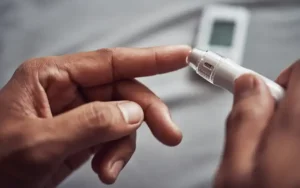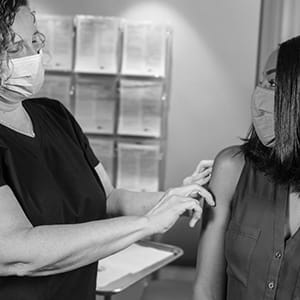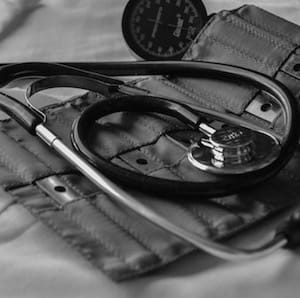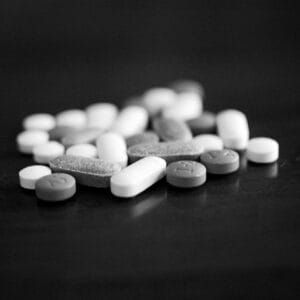Innovating in the Emergency Room
Countless high-stakes decision are made in emergency rooms and emergency departments every day, making the design of processes and communications that much more important. A behavioral lens can help support both providers and patient outcomes in this fast-paced environment. In collaboration with Massachusetts General Hospital (MGH), we apply behavioral insights to support emergency physicians with the aim of improving health and well-being.
Rapid Response to COVID-19
Widespread cases of COVID-19 in the U.S. have strained emergency departments across the country. As hospitals and health care providers manage an influx of patients, behavioral science is one more tool that can support their efforts. With the Emergency Department (ED) at MGH, we worked on two different behavioral innovations to help with the rapid response to COVID-19.
First, we focused on using behavioral science to enhance the processes by which COVID-19 care-related changes were communicated in the ED. Among the many challenges created by the COVID-19 pandemic for ED staff, one of the most difficult but least discussed has been the need for rapid dissemination and uptake of new information by healthcare teams. Many of the methods utilized early on in the pandemic were effective but resource intensive. These included frequent email updates, in-person rounding by the physician administrative team, and weekly COVID-19 case conferences. It was simply not sustainable to continue these efforts beyond the first few months of the pandemic. In order to address this need, our team designed a less resource-intensive way to continue to provide staff with readily accessible and up-to-date information: a simple, single-page website with the most recent COVID-19 updates and most useful durable information that could be accessed by QR codes around the ED. We expect that the page will continue to ease the burden on providers and increase adherence with shifting protocols.
Second, we explored using behavioral science to decrease burnout among ED providers during the COVID-19 pandemic. Even before COVID-19, emergency medicine historically had higher rates of burnout as compared to other specialties. During COVID-19, it is likely that levels of burnout have only gotten worse in specialties, such as emergency medicine, since these providers have been on the front lines the most. In order to investigate this problem, during the summer of 2020, we administered a survey to ED clinicians to gauge their levels of burnout and ask about potential improvements to help prevent burnout during the pandemic. One of the themes that came up the most in the free response questions was that providers often feel that they do not receive a lot of positive feedback from patient care. In order to increase the amount of positive feedback that providers receive, our team designed a positive feedback report. Although just a small piece of the solution to address burnout, the report is one of the larger ED initiatives around burnout to date and will be an important step in starting to address burnout among ED providers, during and beyond the time of COVID-19. Read the project brief to learn more and view the designs.
Supporting Patients with Opioid Use Disorder
Opioid Use Disorder (OUD) has reached crisis levels across the United States in recent years. Opioid-related overdose and death rates are skyrocketing, particularly on the nation’s east coast.
Massachusetts has one of the largest increases in opioid-related emergency department visits in the nation by far–and one of the largest increases in opioid-related overdoses and deaths, with rates growing four-fold since 2010. Countless headlines attest to the difficulties tackling this alarming public health crisis and providing appropriate evidence-based treatment for the many factors and behaviors that contribute to OUD.
We’re collaborating with MGH to explore insights and approaches from behavioral science to optimize their emergency department OUD treatment protocols and enable physicians to help more patients into effective, evidence-based treatment. MGH is on the front lines of the opioid epidemic, developing innovative approaches that treat substance use disorders along all levels of care—from primary community-based prevention to emergency intervention and treatment to chronic disease management. Key components of the initiative include an on-demand, transitional outpatient clinic and immediate access to buprenorphine in the hospital’s emergency department. We developed interventions from a diagnosis process consisting of interviews with physicians, addiction specialists, nurse practitioners and physician assistants on staff, as well as MGH patients, to understand perceptions, attitudes, and beliefs related to seeking and receiving treatment for OUD within the emergency department.
With funding from the Laura and John Arnold Foundation, this collaboration spanned multiple phases of diagnosis, design, and testing. Following an investigation into the potential barriers and behavior drivers facing patients with OUD in emergency care, ideas42, in close collaboration with the hospital’s Emergency Medicine Department and Bridge Clinic for Addiction Recovery, designed a set of behavioral interventions to be piloted in MGH’s emergency room. The interventions aimed to improve processes and outcomes for emergency medicine care teams, patients and outside support service providers. The intervention package included a set of “badge backers” with conversation cues, a visible commitment to treating OUD, and a simplified visual of the OUD protocol; an electronic notification in MGH’s Electronic Health Record (EHR) prompting providers to order a referral to the Bridge Clinic when indicated; monthly feedback emails to providers; and patient-facing posters that de-stigmatized OUD and prompted patients to ask their providers about treatment options. We look forward to sharing the results of these interventions in the coming months.
It is estimated that substance use disorder costs the United States health care system more than $700 billion annually. Effectively addressing opioid use disorder could result in tremendous public health benefit as well as substantial cost savings. Stay tuned for updates and insights from this effort to support patients in emergency care seeking treatment for OUD over the next year.
Interested in learning more about this work applying behavioral science to a crucial social problem? Reach out to us at info@ideas42.org or tweet at @ideas42 to join the conversation.









